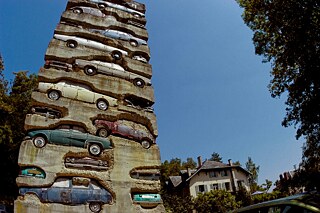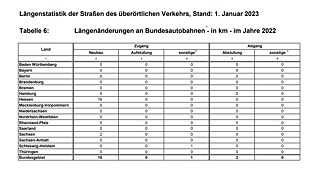Playing with Numbers Statistical poetry

Head for a traffic jam with Jörn Müller and see what happens when statistics become unruly: circumnavigating the equator, multi-level congestion and minimalism in spreadsheets.
Tally up? – great, let’s see the figures: if all the jams that occurred in Germany in 2023 according to the ADAC-Staubilanz (congestion statistics) were laid out end-to-end, there would be a queue of cars behind and in front of me measuring 877,000 kilometres. That’s almost 22 times around the equator. Or, with a total length of 13,155 kilometres of motorway in Germany that year: if you were to distribute the 877,000 kilometres of congestion for 2023 evenly across the German motorway network, each individual kilometre of motorway would be occupied by a multi-level stack of nearly 67 jams. Below me, in a sports car on Level 32 of this stack, the car radio is belting out the traffic and travel news at maximum volume.

Nothing but zeros
The previous year, 2022, the German motorway network was extended by 17 kilometres. We are told this information in a report entitled “Längenstatistik der Straßen des überörtlichen Verkehrs” (total interregional road length) published by the Federal Ministry for Digital and Transport and the Federal Trunk Road Authority. The spreadsheet “Längenänderungen an Bundesautobahnen” (length changes on German motorways) contains nothing but zeros. The table, which is sorted by federal state, lists increases resulting from new construction or upgrades, and decreases from downgrades – as well as “miscellaneous”, which for instance includes correction of measurement errors. According to the spreadsheet, only 16 kilometres of new road were built in Hesse and two kilometres in Saxony, with additions from other sources accounting for one kilometre in Schleswig-Holstein. Two kilometres were downgraded in Hamburg. Apart from that, 78 of the 85 cells in this table show the value zero. I see the zeros in front of me, stacked up in rows and columns. Nothing’s moving – like the wheels of all the cars in the traffic jams. An environmental activist rides by on her home-made cargo bike and gives me a friendly wave.

A thousand years of congestion
According to the ADAC report, the duration of congestion on German streets in 2023 was also a total of 427,000 hours. If I were to take it upon myself to serve time on behalf of all the people who sat in a queue throughout 2023, I would need almost 49 years to do it. If this congestion had been cleared this year, 2023, I would have been standing there since 1974, the year the football World Cup was held in the Federal Republic of Germany (at that time there were still two German states). Gerd Müller – I'm not related to him – scored the decisive goal in the final that made the West German team world champions.While I wait, I become a poet – ready-made lyrical poetry from the motorway and street jargon provided by the ADAC, Federal Ministry for Transport and the Bundesanstalt für Straßenwesen (Federal Highway Research Institute):
Längenänderungen = length increases
Aufstufung, Abstufung, Messfehler = upgrades, downgrades, measurement errors
Verkehrsflächen, Asphaltdeckschicht = transport infrastructure, asphalt surface course
überörtlicher Verkehr = inter-city transport
Kaltrecycling, Schaumbitumen = cold-in-place recycling, foamed bitumen
RoDeO Beton = Directives for the Calculational Dimensioning of Traffic Infrastructures with Concrete Surfaces
temperierte Straße = tempered road
Staudauer = congestion duration
Someone’s hooting behind me. The congestion has finished, we can carry on. Gerd Müller hands me a bunch of blue-lilac cornflowers to thank me for waiting. The exit’s just up ahead. Nearly there. It’s raining concrete and tarmac.


